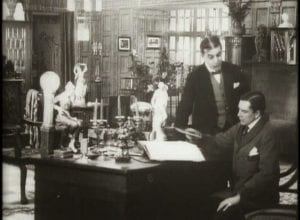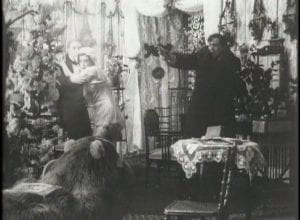In this post, you will read a programme note for Evgenii Bauer’s film Child of the Big City (Ditia bol´shogo goroda, 1914). The aim of this post is to provide viewers with little or know knowledge about the film with a critical introduction to it, to contextualise it briefly and to highlight significant features of the film’s themes and style. The word limit is 750-1000 words.
Child of the Big City (Ditia bol´shogo goroda, 1914)
Alternative title: Girl from the Street (Devushka s ulitsy)
Drama with prologue
1135 metres; 37 minutes
Preserved incompletely, without the opening scenes and without intertitles
Production: Aleksandr Khanzhonkov & Co. Ltd
Director, scenarist, art director: Evgenii Bauer
Cameraman: Boris Zavelev
CAST
Mania/Mary: Elena Smirnova
Man´ka, the heroine as a child: Nina Kozlianinova
Viktor Kravtsov: Mikhail Salarov
Kravtsov’s lackey: Leonid Iost
Kramskoi, Viktor’s friend: Arsenii Bibikov
A dancer: Emma Bauer
Masha, a washerwoman: Lidiia Tridenskaia
Evgenii Bauer is recognised as the pre-eminent early Russian filmmaker and a figure of fundamental importance in the history of world cinema. Already well-known as a theatre set designer when he entered cinema in 1912, Bauer rose to become Russia’s most highly paid director, working prolifically until his death in 1917. Despite the brevity of his career, Bauer directed at least eighty-two films, of which twenty-six are known to be extant. Their range and number enable us to identify the features that secured Bauer’s reputation as the era’s foremost innovator and the creator of a specifically cinematic means of expression that established cinema as distinct from theatre and still photography.
Released on 5 March 1914 and set in contemporary Moscow, Child of the Big City explores changing class and gender relations, themes to which Bauer returned time and again. The film tells the story of Mania, an ambitious young seamstress, who improves her lot by becoming the mistress of the wealthy Viktor Kravtsov, an idealistic but unhappy gentleman, whose romantic disillusionment connects him to the male protagonists of the nineteenth-century Russian literary tradition.
Bauer’s style is highly visual. Known for his inventiveness as a set designer, Bauer sought to overcome the screen’s flatness, building spacious sets and enhancing the illusion of depth by using carefully placed columns, staircases, curtains and pot plants to divide the space into different planes. Bauer’s sets and the objects he places within them are more than impressive backdrops; they always function symbolically to highlight aspects of character and theme. In the set he designed for Viktor’s study, for example, Bauer communicates his hero’s tendency to objectify and fetishize women by decorating it with neo-classical statuettes of scantily-clad women. Similarly, he emblematizes Mary’s greed and predatory materialism by filling her home with an abundance of knick-knacks and an imposing bearskin couch, on which she reclines like a huntress displaying a trophy.
Viktor (seated) and his friend Kramskoi in Viktor’s study Mary’s bearskin crunch (right-hand foreground)
Together with his cameraman, Boris Zavelev, Bauer experimented with cinematic technology, exploring the communicative and affective potential of different types of lighting, camera angles and shots. Thus, he conveys Mania’s rise from working-class poverty to high-society luxury visually, in an innovative low-angle shot of the huge art nouveau staircase that she climbs to reach Viktor’s fashionable nightclub.
Viktor takes Mary to a fashionable nightclub (extract from the film)
Bauer also devised ingenious ways of making the camera mobile, freeing cinema from the static theatrical conventions that had initially shaped its aesthetics. Child of the Big City is notable for featuring, in the nightclub sequence (featured in the clip posted above), an extended track-in, unprecedented in Russia in 1914: with Mary and Viktor settled at a table, the camera suddenly begins to move, advancing past them, over the dance floor and towards a stage where a barefoot Salome dancer performs. The challenge for the viewer is to unravel the meanings of this technically and aesthetically innovative sequence. Does it seek to evoke Mary’s dizzy excitement at the pleasures of high-society affluence? Does it aim to link Mary to the dancer, to characterise her as a contemporary Salome-like femme fatale? Whatever its intent, the sequence also delighted contemporary audiences for another reason: the dancer making this cameo appearance is Bauer’s wife, Emma, a celebrated estrada performer in her own right.
Emma Bauer as the Oriental dancer
Contemporary audiences were similarly entranced by a second dance sequence, in which Mary performs a tango routine. The tango had arrived from Paris in late 1913 and by March 1914 Russia was gripped by ‘tangomania’; there was no more fashionable, or scandalous, figure than the tangistka (tango-dancer). Thus Bauer contrives to characterise Mary as a daring New Woman. That the actress who played Mary was the famous tangistka Elena Smirnova would have strengthened for contemporary viewers the sense of Mary’s absolute modernity and transformed her into an emblem of the new age. It is fitting, therefore, that when Mary sets out for a popular Moscow tango club at the end of the film she is accompanied not by the old-fashioned Viktor, but by her new lover (significantly, Viktor’s former lackey), played by Leonid Iost, himself a well-known tangist.
Mary tangoes with her new lover, played by the tangist Leonid Iost
Bauer’s films are often described as the work of a ‘woman’s director’. His female protagonists are usually their centre of interest, and they are consistently shown to be emotionally stronger, more dynamic and more engaging than their male counterparts. Even when they behave badly, Bauer tends to refrain from moral comment on their behaviour. Nor does he propose easy solutions to the dilemmas his protagonists face. The overriding impression left by Bauer’s films en masse, and by his extraordinary Child of the Big City in particular, is of a society riven by gender and class anxieties, which are far from being resolved.




2 Comments